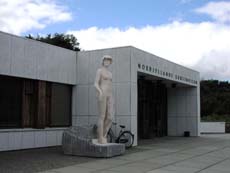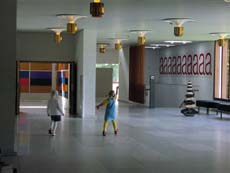index
Art museums
click on images for full-size:




The North Jutland Museum of Art in Aarlborg, Denmark, designed by Alvar Aalto

Interior of the North Jutland Museum

Chinese house, rebuilt at the Peabody Essex Museum in Salem, Massachusetts
"Are art museums theme parks for a broad audience?" [Krens] asked at the Armory, 'or are they specialized institutions of research for a very narrow audience?' Faced with these choices, Krens has apparently decided to steer the Guggenheim in the direction of the former. In Krens' view, the museum as an institution is an eighteenth-century idea in a nineteenth-century box that has outlived its usefulness. As architectural historian Victoria Newhouse observes in her insightful 1998 book Towards a New Museum, art museums were originally thought of as educational institutions that served the public good. Subsidized by robber barons and supported by municipalities, the Metropolitan Museum of Art, the Boston Museum of Fine Arts, the Philadelphia Museum of Art, and similar Neo-Classical stone piles in major cities across the country set out to amass artworks that could be used to recount the history of art from ancient Egypt to the present. But museums today are expected to do more: They must sing for their suppers, either as money-making enterprises or institutions that fuel surrounding economic development. Over time, the ornate design of cathedrals led many worshipers to feel acutely alienated from the Catholic Church. The Protestant Reformation that followed fostered an architectural backlash as well as a spiritual one, producing a spare style that rejected ornamentation. If Holl and Moneo's new designs are any indication, we may be about to witness the contemporary reformation of the museum. Hogafe 1999, 73-5